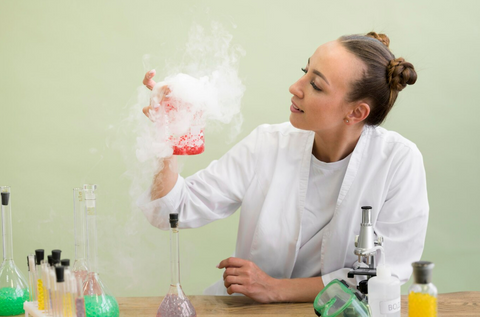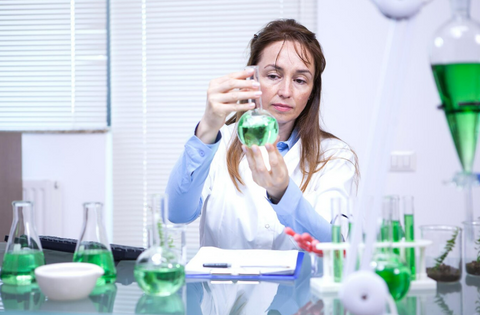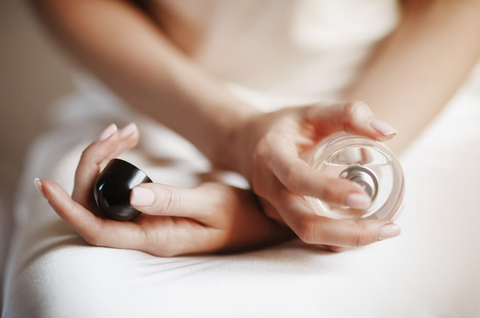The allure of pheromone perfume lies in its potential to enhance social interactions and attract others. However, many users wonder - how long does this effect last? The answer, unfortunately, isn't a simple one. The longevity of pheromone perfume is influenced by several factors, from the wearer's own biology to the specific formulation of the product.
Unveiling the Mystery: Factors Affecting Pheromone Perfume Longevity
Skin Type: The Canvas for Fragrance
Your skin type plays a crucial role in how long pheromone perfume stays effective. It acts like a canvas, influencing how the fragrance interacts with your body and ultimately, how long it lasts. Let's delve deeper into how different skin types affect pheromone perfume longevity:
Drier Skin: A Speedy Absorption
Individuals with dry skin often find that pheromone perfumes don't last as long as they'd hope. This is because dry skin lacks the natural oils and moisture that help fragrances adhere and linger. The fragrance molecules are quickly absorbed or evaporate, leading to a shorter lifespan of the scent.
Here's a breakdown of why dry skin affects longevity:
- Reduced surface area for adhesion: Dry skin tends to have a rougher texture with microscopic cracks and crevices. These imperfections offer fewer places for fragrance molecules to attach, leading to quicker absorption and diffusion.
- Lack of moisture to hold the scent: Fragrance molecules require a certain level of moisture to bind to the skin and stay suspended. Dry skin, lacking this moisture, struggles to retain the perfume, causing it to evaporate faster.
Tips for dry skin
- Moisturize regularly: Apply an unscented moisturizer before using pheromone perfume. This creates a smoother surface for better adhesion and provides the necessary moisture to trap the fragrance molecules.
- Look for oil-based perfumes: Opt for oil-based pheromone perfumes as they tend to evaporate slower compared to alcohol-based ones, offering slightly longer wear time on dry skin.
- Reapply more frequently: Be prepared to reapply your pheromone perfume more often throughout the day, especially in areas prone to dryness like wrists and neck.
Oilier Skin: A Natural Reservoir for Fragrance
Individuals with oily skin generally experience the opposite effect. Their skin acts like a natural reservoir for fragrances, allowing pheromone perfumes to last longer. Here's why:
- Smoother surface for better adhesion: Oily skin has a smoother texture, providing a larger surface area for fragrance molecules to adhere to and stay put.
- Natural oils act as a barrier: The natural oils present in oily skin act as a barrier, slowing down the evaporation of fragrance molecules, leading to a longer-lasting scent.
- Avoid over-applying: Oily skin already provides a good base for fragrance retention, so avoid over-applying the perfume, which can lead to an overpowering scent.
- Blotting throughout the day: While oily skin helps the perfume last longer, it can also lead to a shiny appearance. Use blotting papers throughout the day to control excess oil without affecting the fragrance.
- Choose lighter fragrances: Opt for lighter pheromone perfume formulations or consider layering them with lighter fragrances to avoid an overly strong scent.
Product Formulation: Unveiling the Secrets of Longevity
The formulation of a pheromone perfume plays a crucial role in determining how long it will last on your skin. Let's delve deeper into two key aspects:
Base Type: Choosing the Right Carrier
- Oil-based perfumes: These perfumes utilize natural oils like jojoba, coconut, or almond as their base. Due to the thicker consistency and slower evaporation rate of these oils, the fragrance and pheromones tend to stay on the skin for a longer duration, typically 6-10 hours. This makes them ideal for those seeking a long-lasting effect. However, oil-based perfumes may feel heavier on the skin and can potentially stain clothing if not applied carefully.
- Alcohol-based perfumes: These perfumes use alcohol (usually ethanol) as their primary solvent. Alcohol evaporates much faster than oil, resulting in a shorter lifespan of the fragrance, typically 2-4 hours. However, they offer a lighter, more refreshing feel and dry down quickly, making them better suited for warmer climates or individuals with oily skin.
Pheromone Concentration: Striking a Balance
Pheromone concentration refers to the amount of pheromones present in the perfume. While some might believe a higher concentration signifies a stronger effect, the relationship between concentration and longevity is not always direct. Here's what you need to consider:
- Higher concentration does not always equate to longer-lasting effects. The interaction between pheromones and the skin is complex and influenced by various factors like body chemistry and environmental conditions.
- Over-concentration can be counterproductive. Using excessive amounts of pheromones can potentially overwhelm the olfactory receptors and even backfire, leading to an unpleasant odor or unintended reactions.
- Focus on quality over quantity. Choose perfumes from reputable brands that prioritize the purity and effectiveness of the pheromones used, regardless of the concentration level.
Environmental Conditions: Unveiling the Impact of Temperature and Humidity
Temperature
- Hot and Humid Environments: The double whammy of high temperature and humidity poses the biggest threat to the longevity of pheromone perfume. Hot weather triggers increased sweat production, which acts like a solvent, dissolving and washing away the fragrance molecules. Additionally, high humidity creates a saturated atmosphere, hindering the fragrance's ability to evaporate and disperse effectively.
- Moderate Temperatures: Cooler environments, with temperatures around 68°F (20°C), offer a sweet spot for fragrance longevity. Lower temperatures reduce sweat production, allowing the fragrance to remain intact on the skin for a longer duration.
- Cold Temperatures: While cooler temperatures offer some benefits, extreme cold can also negatively impact fragrance life. Cold constricts blood vessels, reducing blood flow to the skin's surface. This decrease in blood flow can impede the diffusion of the fragrance molecules, making them less noticeable.
Humidity
- High Humidity: While it might seem counterintuitive, moderate to high humidity can actually prolong the life of pheromone perfume. Humid air acts like a trap, preventing the fragrance from evaporating quickly. However, it's important to remember that high humidity can also create a stuffy and unpleasant atmosphere, which might outweigh the benefits of extended fragrance life.
- Low Humidity: Dry environments, especially with low humidity, accelerate the evaporation of fragrance molecules. This leads to a faster breakdown of the pheromone perfume, requiring more frequent reapplication.
Additional Considerations
- Sun exposure: Direct sunlight can degrade the chemical structure of fragrance molecules, further reducing the lifespan of the perfume. Wearing hats and seeking shade can help protect your perfume from sun damage.
- Air circulation: Moving air can help disperse the fragrance more effectively, but it can also accelerate evaporation. Finding a balance between air circulation and preventing rapid fragrance loss is crucial.
Individual Factors
Body Chemistry
Our bodies are like intricate laboratories, producing a unique blend of natural oils, enzymes, and bacteria. This unique "chemical fingerprint" plays a significant role in how fragrances, including pheromone perfumes, interact with our skin and ultimately affect their longevity.
- Skin pH: The pH level of your skin acts like a barrier, influencing how readily it absorbs and holds fragrance molecules. A slightly acidic pH (around 5.5) is considered ideal for fragrance retention. If your skin leans more alkaline, the fragrance might not adhere as well, leading to quicker evaporation.
- Natural Oils: Individuals with oilier skin types tend to benefit from longer-lasting fragrance experiences. The natural oils present on their skin act as a canvas, allowing the perfume molecules to adhere more effectively and release the scent gradually throughout the day. In contrast, those with drier skin might see the fragrance dissipate faster as there's less surface area for the molecules to bind to.
- Hormonal Fluctuations: Our hormone levels fluctuate throughout life, impacting various bodily functions, including skin oil production. For example, hormonal changes during menstruation or pregnancy can alter the skin's pH and oil production, potentially affecting the performance of pheromone perfumes.
Activity Level
Our activity level directly influences how long a fragrance, including pheromone perfume, stays noticeable.
- Increased Physical Activity: As we engage in physical activity, our body temperature rises, and we start sweating. Sweat acts as a solvent, breaking down the fragrance molecules and accelerating their evaporation. This translates to a shorter lifespan for the perfume and the potential need for more frequent reapplication.
- Sweat Composition: While sweat itself doesn't have a strong odor, it can react with the unique bacteria present on our skin, creating individual body scents. These scents can interact with the pheromone perfume, potentially altering its overall aroma or masking its effects.
Additional Factors
- Diet: Certain foods can influence body odor and potentially interact with the pheromone perfume. For instance, foods rich in strong-smelling ingredients like garlic or onions might compete with the fragrance's intended effect.
- Medications: Some medications can alter body chemistry and potentially interfere with the performance of pheromone perfumes. It's always recommended to consult a healthcare professional before using any product alongside existing medications.

Decoding the Ingredients: Understanding Pheromone Composition
Synthetic vs. Natural Pheromones
Synthetic Pheromones
- Availability and Cost: These are more readily available and typically cost less than natural pheromones. They are mass-produced in labs, making them a commercially viable option for most perfume brands.
- Effectiveness: The effectiveness of synthetic pheromones in humans is still under debate. While some studies suggest they may have subtle effects on mood or perception, strong scientific evidence for their ability to significantly influence attraction remains inconclusive.
- Customization: Synthetic pheromones can be customized by mimicking the specific pheromone profiles of different species, such as humans or specific animals. This allows for targeted fragrance design in theory, although its actual effectiveness in humans needs further research.
Natural Pheromones
- Availability and Cost: Natural pheromones are much rarer and more expensive than synthetic ones. They are typically extracted from animal sources like boar urine, musk glands of deer, or bee venom sacs, raising ethical concerns regarding animal welfare and sustainability.
- Ethical Concerns: The ethical implications of sourcing natural pheromones are a major consideration. Critics argue that the process can be cruel to animals, with potential for over-harvesting and inadequate animal welfare practices.
- Efficacy and Legality: The effectiveness of natural pheromones in humans is even less understood than synthetic ones. Additionally, the legality of using animal-derived pheromones in some countries is restricted due to potential safety and ethical concerns.
Pheromones vs. Fragrances
While both pheromones and fragrances are used in perfumes, they differ significantly in their function and purpose:
Pheromones
- Function: Act as chemical messengers, sending subconscious signals to others. They are typically odorless and undetectable by the conscious human sense of smell.
- Target: Specific receptors in the olfactory system, triggering biological responses like attraction, aggression, or alarm. These responses often occur subconsciously, influencing behavior without conscious awareness.
- Examples: Androstenone (found in male sweat) and estratetraenol (found in female saliva) are two commonly studied human pheromones, although their effectiveness in influencing behavior remains debated.
Fragrances
- Function: Enhance the overall scent profile of a perfume, often masking body odor and creating a pleasant aroma. They can be derived from natural sources like essential oils or synthesized in labs.
- Target: Primarily the conscious sense of smell, providing an olfactory experience that can be enjoyable or stimulating. They do not directly influence behavior but can contribute to feelings of confidence or attractiveness through their pleasant scent.
- Examples: Popular fragrance notes include lavender, vanilla, citrus, and various floral scents, each contributing to the overall aroma and experience of the perfume.

Beyond Longevity: Exploring the Science of Pheromones
The Debated Role of Pheromones in Humans
While the existence of pheromones in animals is well-established, their function and impact on human behavior remain a subject of ongoing scientific debate. Here's a deeper dive into the complexities:
- Limited Scientific Evidence: Numerous studies have attempted to investigate the influence of pheromones on human attraction. Some research suggests potential effects, particularly in areas like menstrual synchronicity (women's cycles aligning when living close together) or maternal bonding between mothers and babies. However, these findings often lack conclusive evidence and face methodological challenges.
Challenges: Replicating research findings consistently and isolating the specific role of pheromones from other factors (e.g., cultural expectations, individual preferences) prove difficult. Additionally, ethical considerations often restrict research methods, making it hard to conduct definitive studies.
- The Complexity of Attraction: While pheromones might play a subtle role in some aspects of human social interactions, it's crucial to remember that attraction is a multifaceted phenomenon. Cultural background, personal experiences, shared values, and individual preferences all contribute significantly to whom we find attractive.
Cultural Differences: Beauty standards and what constitutes "attractive" vary widely across cultures. What someone finds appealing in one culture might not hold the same significance in another, highlighting the non-universal nature of pheromones' influence.
Individual Preferences: Beyond cultural norms, personal preferences play a powerful role in attraction. Traits like kindness, intelligence, humor, and shared interests significantly influence who we find attractive, further underlining the complexity of attributing attraction solely to pheromones.
Ethical Considerations and Responsible Marketing
Given the uncertainties surrounding the effectiveness of human pheromones, ethical concerns and responsible marketing practices become paramount.
- Transparency is Key: Consumers deserve complete transparency regarding the ingredients and claims made by pheromone-based products. Manufacturers should clearly state the type and concentration of pheromones used, acknowledge the limitations of scientific evidence supporting their effectiveness, and avoid making exaggerated claims about their impact on attraction.
- Avoiding Misleading Tactics: It's essential to avoid marketing strategies that create unrealistic expectations and potentially exploit consumer vulnerability. Claims like "guaranteed attraction" or "irresistible to the opposite sex" are misleading and unethical.
Focus on Honesty: Marketing efforts should be honest and transparent, focusing on the potential benefits of pheromone-based products in a broader context of social interaction and self-confidence.

Maximizing the Magic: Tips for Extending Pheromone Perfume Life
Proper Application Techniques
- Target Pulse Points: Pulse points, like the wrists, inner elbows, and behind the ears, have a higher body temperature, which helps to activate and diffuse the fragrance. Apply a small dab of perfume directly onto these areas for optimal scent projection.
- Minimize Rubbing: Friction can damage the delicate molecules of both pheromones and fragrances. Gently press the applied perfume onto your skin to avoid breaking down the scent.
- Less is More: Start with a small amount of pheromone perfume, as overapplication can be overpowering and even counterproductive. You can always add more later if needed.
Layering with Fragrances
- Complementary Scents: Pairing your pheromone perfume with a complementary eau de toilette or eau de parfum can create a captivating and personalized scent experience. Consider fragrances that share similar base notes, like vanilla, musk, or sandalwood, to achieve seamless blending.
- Layering Order: Apply your preferred fragrance first, allowing it to dry completely. Then, add a small amount of pheromone perfume on top of the pulse points. This layering technique ensures that the pheromones remain at the forefront of the scent profile, while the underlying fragrance enhances the overall aroma.
Storage and Re-application
- Cool and Dark: To preserve the delicate nature of pheromones and fragrances, store your perfumes in a cool, dark place away from direct sunlight and heat. This will help prevent the scent from degrading and losing its potency.
- Travel-Friendly: Consider decanting a small amount of your perfume into a travel-sized atomizer for easy reapplication throughout the day. Choose a dark-colored glass atomizer for optimal protection.
- Strategic Re-application: Throughout the day, re-apply a small amount of perfume to maintain the desired effect. Focus on areas where the fragrance tends to fade first, such as the wrists and behind the ears. Be mindful of the occasion and adjust the reapplication frequency accordingly, avoiding overapplication in close quarters.
Conclusion
While pheromone perfumes and their longevity are interesting, true connection goes beyond scent. Focus on personal development: hone communication skills, cultivate passions, prioritize self-care, and project confidence. Remember, the scientific support for pheromones influencing human attraction remains debated. Instead of relying solely on them, build authentic connections by getting to know others, finding common ground, and fostering honest communication. True attraction stems from a combination of personality, values, and genuine connection, not just a fragrance.

